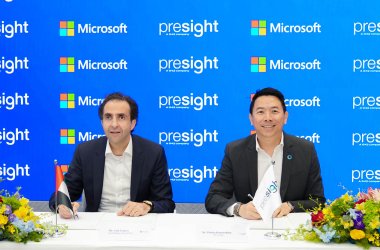 Oracle and Microsoft have announced a partnership that will see Oracle’s database, application server, Java programming language and other products find a home inside Microsoft’s Azure cloud service.
Oracle and Microsoft have announced a partnership that will see Oracle’s database, application server, Java programming language and other products find a home inside Microsoft’s Azure cloud service.
The deal, which will also provide Oracle support for Microsoft’s Windows Server Hyper-V virtualisation platform, is a “great example of partnering to deliver what our enterprise customers need,” Microsoft CEO Steve Ballmer said during a press conference Monday. “It’s about time, and we’re really glad to work in this much newer and constructive way with Oracle.”
“Customers need and want more flexibility to adapt in a rapidly changing business landscape,” said Oracle co-President Mark Hurd during the press conference. “This gives customers choice in how they access and deploy our software.”
Oracle support for Azure and Hyper-V is effective Monday. Customers with Oracle licences will be able to use them in Azure deployments, although those who do should be mindful of special rules Oracle has drawn up for “authorised cloud environments,” including Azure and Amazon Web Services.
In addition, Microsoft plans to offer Infrastructure Services instances of Oracle products, including its database and WebLogic Server, and Oracle in turn will offer customers the ability to run its Linux distribution on Azure.
The partnership also calls for Microsoft to provide “fully licensed and supported Java” in Azure. While Azure has offered some limited Java capabilities, “we think this makes Java much more first-class with Oracle support,” said Satya Nadella, president of Microsoft’s Server and Tools division.
It wasn’t immediately clear when full Java support and the Infrastructure Services instances of Oracle software would be available.
In the meantime, industry watchers will no doubt dissect the announcement for its competitive implications.
While Oracle and Microsoft have worked amicably together on various matters, “in the world of cloud computing that kind of behind-the-scenes collaboration is not enough,” Ballmer said. “People wanted more from us. People wanted more from Oracle.”
In one sense, Oracle was compelled to make the pact with Microsoft, given the vast installed base of customers running Oracle workloads on top of Windows Server. Those customers, in exchange for the handsome annual maintenance fees they pay Oracle, no doubt expect the vendor to expand options for Windows-based deployments as they become available, whether on-premises or in the cloud.
Hurd alluded to the point during the press conference.
Customers simply “are committed to a lot of Microsoft technology,” Hurd said. Oracle and Microsoft “do different things, and there are a few things we both do,” Hurd said. “It just makes sense for us to continue to improve our own capabilities but also allow customers the ability to leverage both of our capabilities together.”
Oracle has its own cloud service similar to Azure, but the pact with Microsoft nonetheless fits its strategy, according to Hurd. “Our cloud is an open cloud,” he said. “It’s about the [intellectual property], not the delivery architecture. The fact that more people get access to our IP is favourable. It’s good for our customers and therefore good for Oracle.”
The deal also “gives Microsoft clear competitive advantages against two of its top rivals,” Forrester Research analyst James Staten said in a blog post on Monday. It strengthens Hyper-V against VMware’s vSphere and gives Windows Azure “near equal position” against Amazon Web Services (AWS) in the cloud platform wars, he wrote. Staten also noted that the fully licensed support covers all Oracle software, while AWS has a similar support relationship with Oracle.
Oracle is offering its next-generation Fusion Applications through its cloud service, which also includes PaaS (platform as a service) capabilities for extending the software.
There’s no doubt Oracle would prefer customers stick to its own cloud, but it is “wisely acknowledging the market momentum behind AWS and Windows Azure and ensuring Oracle presence where its customers are going,” Staten added. “These moves are also necessary to combat the widespread use of open-source alternatives to Oracle’s middleware and database products on these new deployment platforms.”





